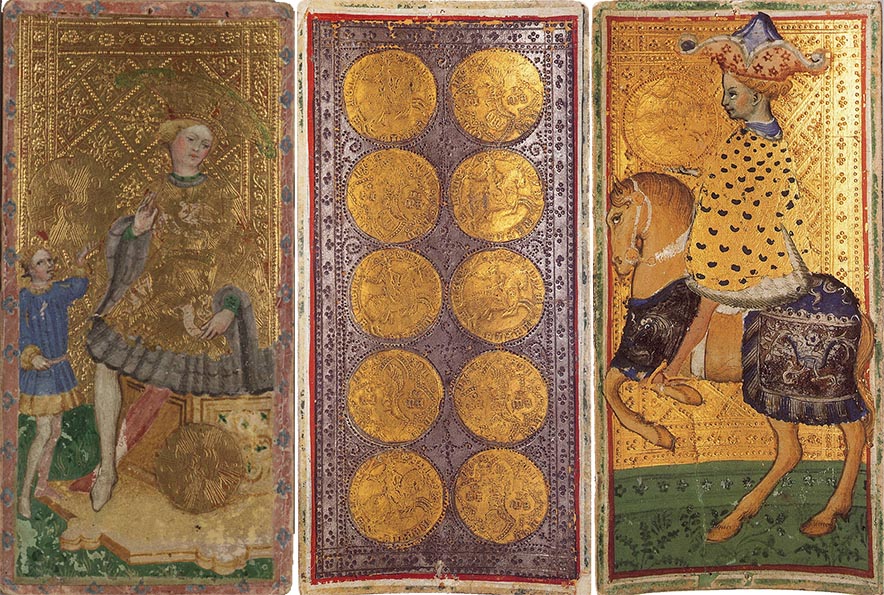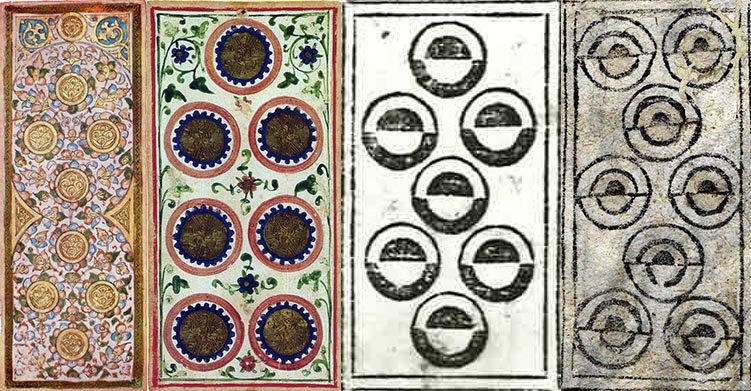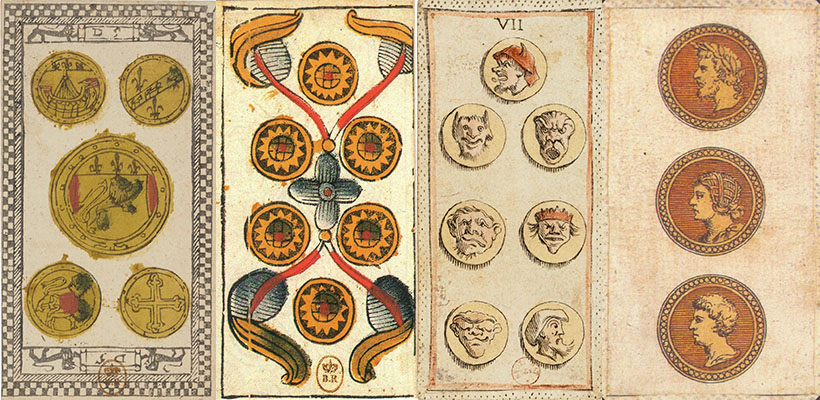THE TAROT WHEEL
THE SUIT OF COINS
The Coin is an important symbol for a ruler of a country. In medieval times, a Coin portrayed the name and symbolism of the ruler, like the Biscione symbol on the leftmost coin, made during the rule of Filippo Maria Visconti. In 1462 Francesco Sforza reintroduced what was common in Classical times, in putting the portrait of himself on the Milanese coins. This portrait was the perfect symbol for their personal power and wealth. The coins here above are some of the coins that have been minted during the reign of the Milanese Dukes in the 15th Century. From left to right we see the Golden Dukato of Filippo Maria Visconti (1412 - 1447), Francesco Sforza (1450 - 1466), Galeazzo Maria Sforza (1466 - 1476), Gian Galeazzo Sforza (1476 - 1494), who became Duke at the age of 9 years old and Ludovico Maria Sforza (1494 - 1499) also called El Moro, brother of Galeazzo Maria Sforza who ruled many years instead of his nephew and who was probably the driving force for killing him. When we see these coins, the ultimate sign of power, it is easy to explain that the coin was one of the symbols on the Italian Trionfi decks.
On the previous page, we have learned that the Coins are associated with solid material, the Element Earth, the element having the lowest energy state. Coins have receptive female characteristics. Female characteristics can be associated with a young woman object of Love, or as a mother, taking care of her family. As for Coins, the association is with the Goddess Gaia, also known as Mother Earth. Here we are considering an elder woman, a mother, managing the family economics.
Speaking more generally, what other associations can we make with the suit of Coins? Let us first consider some general aspects of our live,
Coins are associated with money, so you can associate them to our well-being, be it our wealth or our health. For being happy, money is not required, but it certainly helps. A happy man is a well-fed man, so the body part with which Coins can be associated is our stomach. As a result, the Coins are specifically dealing with our own person, with our situation, our health, our work, our wealth (or poverty). If the Tarot is speaking in sentences, it is talking in the first person and its phrases start with I or are concerning Me. If you are reading the Tarot, and many Coins are turning up, the spread is essential talking about the Consultant, about his or here situation.
In the Tarot, the Virtues are important allegorical figures, representing our moral values. The element Earth, and so the suit of Coins, is associated to the Virtue Prudence. You have to be very prudent to stay in good health and to keep your savings save. In Ancient Greece, Prudence was considered essential to acquire wisdom. When appearing in the Tarot, as in the Trionfi deck of Ercole I of Este, Prudence is portrayed on the highest card, situated in the axis of the Tarot Wheel.
In modern card decks, the suits with receptive female characteristics are colored red and the suit corresponding to Coins is the suit of Diamonds
On the oldest card decks commissioned by Filippo Maria Visconti, the suit of coins was illustrated using Gold as the most important color. On the Visconti di Modrone the members of the court wear golden cloths covered with the symbol of Gian Galezzo Visconti, first Duke of Milan and father of Filippo Maria, a white turtledove (symbol of his first wive) standing on a banner mentionning his device "a bon droyt", indicating that the Visconti family is the rightful ruler over Milan. Behind the bird and the banner, we see a wavy (representing heath) and radiant (representing light) sun. The same wavy and radiant sun is also depicted on the coins that are shown on the court cards. On the numbered cards, a copy of the Golden Dukato that was minted during his reign. On the Brera Brambilla deck, made short before Filippo Maria Visconti died, the Dukato is shown on all cards of the suit of Coins. The members of the court don't have heraldic elements on their cloths, but they wear a golden suit, covered with golden feathers. In the following figure, some examples.
From left to right the King of Cups of the Visconti di Modrone deck, the Ten of Coins of the Brera Brambilla deck and the Knight of Coins also of the Breara Brambilla deck. The horse on which the knight is sitting is covered with a tissue on which is depicted the Piumai, a Crown with a palm branch and an olive branch sticking out of it, the personal symbol for Filippo Maria Visconti. All this gold must have been perfect for the personal ego of Filippo Maria Visconti. The later hand-painted decks were more sober. On the Visconti Sforza deck appear on all coins only the wavy and radiant sun. The clothes of the court members are no pure gold anymore, although they still have a golden flower in front of the radiant sun against a hexagonal blue pattern on their clothes. From the Este decks, only the King of Coins is surviving, not enough to conclude anything.
The printed cards don't need to glorify a specific ruler. The coins are much simpler. Here below eight examples showing the development of the Coins during the years. I show only numbered cards because we are most interested in the suit symbol itself.
In this illustration, all cards have been scaled down to the same vertical size, in reality there are significant differences in size. As an example, the original Visconti Sforza cards are twice as high as the cards of the Rosenwald Deck. On the first row we see from left to right the Eight of Coins of the Mamlûk Deck (<1500), the Seven of Coins of the Visconti Sforza deck (+1452), the Seven of Coins on the Rosenwald sheet (+1500) and the Eight of Coins of the Budapest sheet (+1500). On the second row the Five of Coins of the Tarot of Paris (+1625), the Six of Coins of the Vievil Tarot (+1645), the 7 of Coins of the Tarocchino deck made by Mitelli (+1665) and finally the 3 of Coins of the Minchiate Florentine (+1720). Sometimes the coins have a drawing on it, but the reason for it is not always clear, at least not for me. I will not go into a detailed analysis of the symbols of each deck, something that is not critical for understanding the Tarot. What is important for us to understand, is that the only thing that counts on these cards, is the number of Coin symbols and nothing else. Everything else that has been added might have had some significance, that people from that specific time and region could understand, but not for us, only the suit symbol and the number of times they are occurring are significant. Be careful, for specific decks or some individual cards this might be different.
To conclude, the Coins are talking about the Consultant of the cards, be it ourselves when meditating or be it a Consultant in a card reading session. The Coins learn us that we should not forget ourselves when considering helping someone else. You cannot help anyone if you're not in a good shape yourselves. So keep taking care of yourselves, keep your body in a good shape. Nothing is wrong with caring about yourselves.





